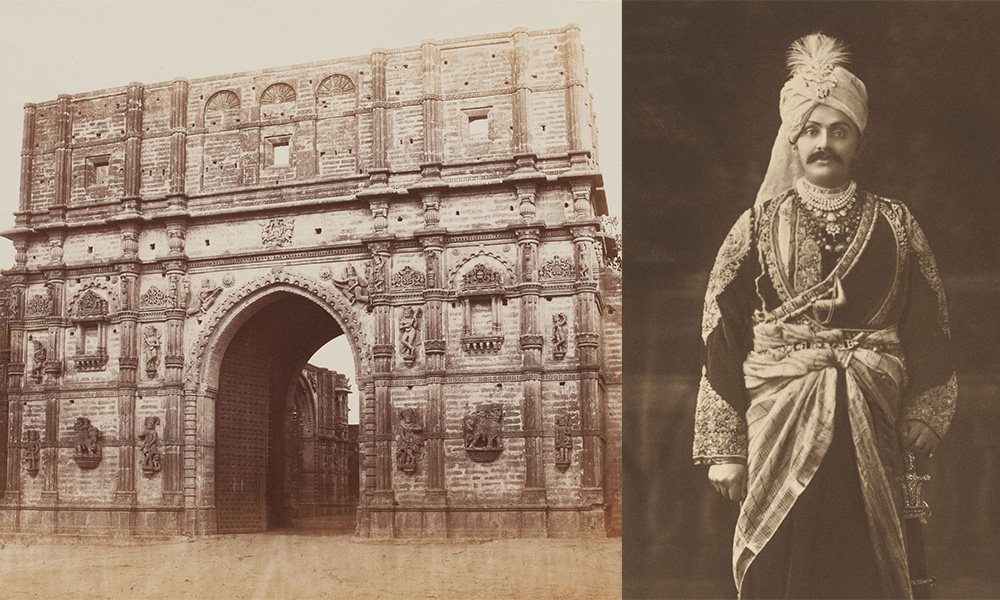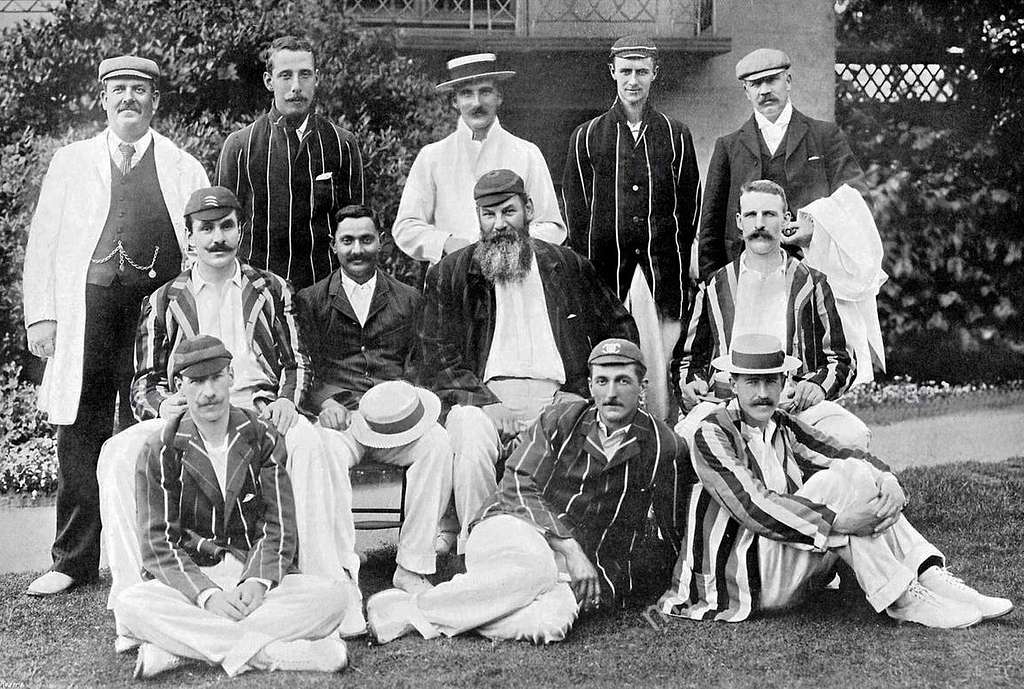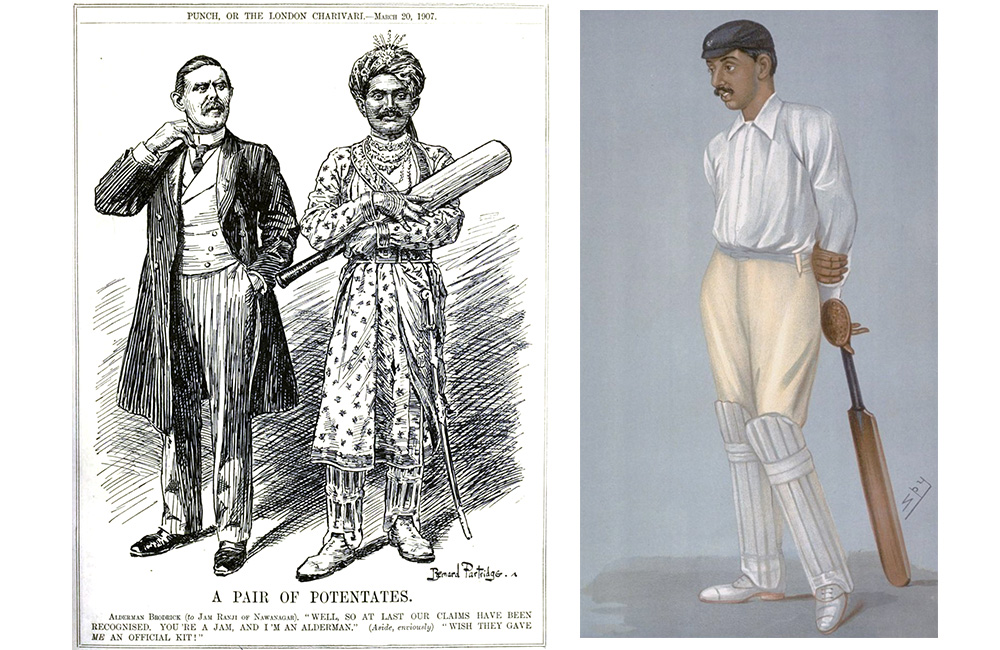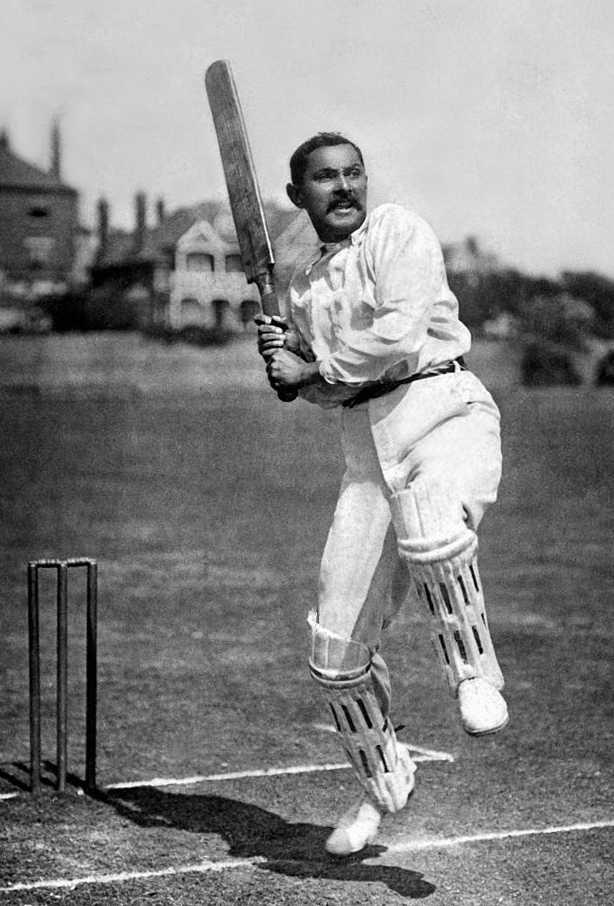
Left: Jamnagar-Gateway (Khambalia Gate, Jamnagar, Gujarat), c. 1850-1880, James Burgess © Sarmaya Arts Foundation (2016.2.1); Right: ‘His Highness Jam Shri Ranjit Singhji Jam of Jamnagar’, 1911, from the ‘Imperial Durbar Album of Indian Princes: Volume I’ by Purshotam Vishram Mawjee © Sarmaya Arts Foundation. (2021.18.2 (78))
Pictured here is the gateway to Jamnagar, capital of one of the most important princely states of Saurashtra. The city was founded by Jam Rawal in 1540 and initially named Nawanagar, ie the ‘new township’. Rawal, a Jadeja Rajput ruler, founded the state of Jamnagar following his emigration from Kutch. Four centuries later, one of his descendants would also make history by playing a sport that the original Jam Rawal wouldn’t even recognise. The sport was cricket and the stylish royal to wield the willow was Ranjitsinhji Vibhaji II.
Ranji Trophy, India’s premier first-class cricket championship series, is named after Ranjitsinhji Vibhaji II. He was the first Indian to play international test cricket in 1897. Ironically, he never played for India. But then, there was nothing typical about this sportsman’s career right from the start.

Gentlemen XI for the fixture vs Players at Lord’s Cricket Ground, London, 1899. Back row: (L-R): Sherwin; Umpire, W.M.Bradley, A.C.MacLaren, C.L.Townsend, West, Umpire. Middle row:(L-R): G.MacGregor, K.S.Ranjitsinhji, W.G.Grace, R.M.Poore. Front: (L-R): F.S.Jackson, C.B.Fry, D.L.A.Jepson.
Born in 1872 to a farmer in Kathiawar, Ranjitsinhji life was filled with cinematic twists and turns. At the age of 6, he found himself in line to succeed the Jam Sahib of Nawanagar, Vibhaji II Ranmalji. But court politics and royal intrigues derailed this succession plan and the would-be scion found himself in a limbo: he could neither resume life in the village as a farmer’s son, nor could he assume the position of Jam Sahib for which he’d spent months preparing. During the vetting process for the role of Jam Sahib, however, he had made an impression on the British authorities. If nothing else, the thwarted heir would receive a good education.

Left: Caricature from Punch Magazine March 20, 1907, Bernard Partridge; Right: “Ranji”, caricature by Spy in Vanity Fair, 1897
Ranjitsinhji was introduced to cricket at a posh school for princely wards, Rajkumar College in Rajkot. But it was later, while studying in Cambridge University that he was exposed to the sport at its most competitive levels. He started working on this game and developed a unique batting style. After playing for Cambridge and Sussex in England’s county cricket circuit for a couple of years, in 1897, he made his international test debut in Australia. That same year, he published a best-seller: Prince Ranjitsinhji’s The Jubilee Book of Cricket.
In this work, Ranjitsinhji, one of the most famous and eccentric of late Victorian cricketers, known for his unorthodox batting stance and propensity for breaking batting records, compiled a personal account of cricketing insight that became a bestseller. Despite it being an iconic work of its time, little has been written about Ranjitsinhji’s text and the process by which a cricketing legend was translated into a bestselling author.
– The Publication History of Ranjitsinhji’s The Jubilee Book of Cricket by David Finkelstein
While Ranjitsinhji played cricket till 1904, even serving as captain of Sussex during that time, he also began a parallel career in writing. Even though he had styled himself as a prince and lived a lavish life in England, his royal inheritance back home in Nawanagar was still not secured. He worked as a journalist and author, and took frequent loans to pay off the bills. Meanwhile, in India, he plotted and schemed with the best of them to ascend the throne he’d been promised at age 6. This would finally happen in 1906, when he was crowned Jam Sahib of Nawanagar.
Each stage in the life of Ranjitsinhji Vibhaji II merits a book of its own, from the royal durbar to the cricket pitch and back again. What makes his life fascinating is that he was a multi-faceted, complex man. As a ruler, his legacy is more sturdy as the one to modernise the capital city of Jamnagar. As a cricketer, however, his legacy is complicated. He was the first Indian to become an international cricketing sensation, but his most tangible contribution to the game in India itself may well be the series named after him.

Kumar Shri Ranjitsinhji, Sussex and England, circa 1905. Photo by George Beldam
A year after his death, the Board of Cricket Control in India launched a premier first-class cricket championship. The trophy was donated by another royal cricketer, Maharaja Bhupinder Singh of Patiala. He named it for his dear friend and prince among players, Ranji.
References
Ranji Trophy – 85 years and counting, The Week
The Publication History of Ranjitsinhji’s The Jubilee Book of Cricket by David Finkelstein
Remembering Ranjitsinhji, the first Indian who played Test cricket for England, The Print



